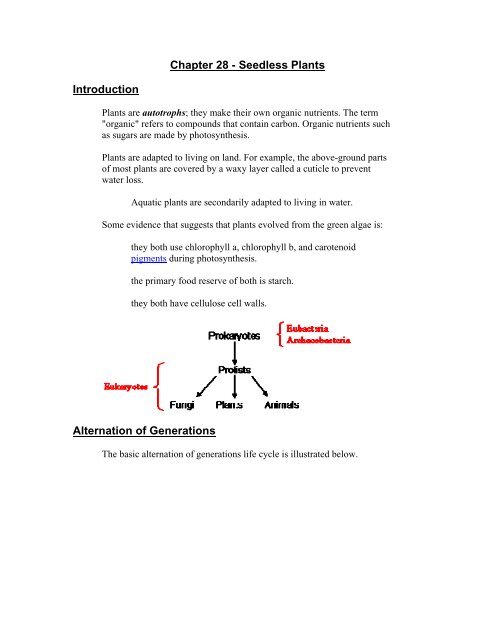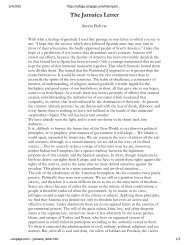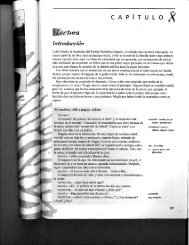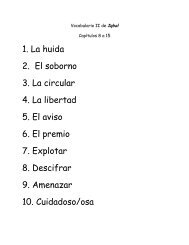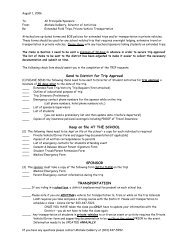Chapter 28 - Seedless Plants - Schools
Chapter 28 - Seedless Plants - Schools
Chapter 28 - Seedless Plants - Schools
Create successful ePaper yourself
Turn your PDF publications into a flip-book with our unique Google optimized e-Paper software.
<strong>Chapter</strong> <strong>28</strong> - <strong>Seedless</strong> <strong>Plants</strong><br />
Introduction<br />
<strong>Plants</strong> are autotrophs; they make their own organic nutrients. The term<br />
"organic" refers to compounds that contain carbon. Organic nutrients such<br />
as sugars are made by photosynthesis.<br />
<strong>Plants</strong> are adapted to living on land. For example, the above-ground parts<br />
of most plants are covered by a waxy layer called a cuticle to prevent<br />
water loss.<br />
Aquatic plants are secondarily adapted to living in water.<br />
Some evidence that suggests that plants evolved from the green algae is:<br />
they both use chlorophyll a, chlorophyll b, and carotenoid<br />
pigments during photosynthesis.<br />
the primary food reserve of both is starch.<br />
they both have cellulose cell walls.<br />
Alternation of Generations<br />
The basic alternation of generations life cycle is illustrated below.
The diploid plant that produces spores is called a sporophyte. The haploid<br />
plant that produces gametes is called a gametophyte.<br />
Some protists also have an alternation of generations life cycle but the<br />
structures that produce gametes in protists are usually single cells. <strong>Plants</strong><br />
produce gametes in multicullar structures that have an outer protective<br />
layer. Sperm are produced in structures called antheridia (sing.<br />
antheridium), eggs are produced in archegonia (sing. archegonium),. As<br />
in protists and fungi, spores of plants are produced in sporangia (sing.<br />
sporangium).<br />
A dependent sporophyte is a sporophyte that is small and grows attached<br />
to the gametophyte. It obtains nutrients from the gametophyte. An<br />
independent sporophyte grows separately from the gametophyte.<br />
Similarly, a dependent gametophyte is small and grows attached to the<br />
sporophyte while an independent gametophyte grows separately from the<br />
sporophyte.<br />
The evolutionary trend in plants has been from plants with a dominant<br />
gametophyte and reduced, dependent sporophyte (ex. Mosses) to plants<br />
with a dominant, independent sporophyte and a reduced, dependent<br />
gametophyte (ex. Seed plants).<br />
Classification of <strong>Plants</strong><br />
We will study 12 divisions (phyla) of plants.<br />
Classification<br />
Characteristics<br />
Liverworts (Division Hepatophyta)<br />
Mosses (Division Bryophyta)<br />
Bryophytes (no vascular tissue)
Hornworts (Division Anthocerophyta<br />
Whisk ferns (Division Psilotophyta)<br />
Club mosses (Division Lycophyta)<br />
Horsetails (Division Sphenophyta)<br />
Ferns (Division Pterophyta)<br />
Conifers (Division Coniferophyta)<br />
Cycads (Division Cycadophyta)<br />
Ginkgos (Division Ginkgophyta)<br />
Gnetophytes (Division Gnetophyta)<br />
Flowering <strong>Plants</strong> (Division<br />
Anthophyta)<br />
Monocots (Class Liliopsida)<br />
Dicots (Class Magnoliopsida)<br />
<strong>Seedless</strong> vascular plants<br />
Gymnosperms (vascular, naked seeds)<br />
Angiosperms (vascular, protected<br />
seeds)<br />
Bryophytes<br />
General Characteristics<br />
Mosses<br />
Mosses, liverworts, and hornworts lack vascular tissue for transporting<br />
water and nutrients. This restricts their size. The largest are less than 20<br />
cm (8 in.).<br />
Rhizoids are root-like structures that absorb water and nutrients. They do<br />
not have true roots, stems, or leaves because they lack vascular tissue.<br />
Bryophytes are generally restricted to moist areas because the sperm are<br />
flagellated and therefore require at least a film of water to swim to the<br />
egg.<br />
The sporophyte of bryophytes is dependent on the gametophyte, that is, it<br />
derives its nutrition from the gametophyte. The gametophyte is<br />
independent.
Left: Moss growing on a rock<br />
Left: The sporophytes are<br />
attached to the gametophytes.<br />
Reproduction<br />
Spores germinate to produce a branching horizontal filament called a<br />
protonema. The familiar green gametophyte body and rhizoids arise from<br />
the protonema.
Left: Moss capsule containing spores.
L<br />
M<br />
a<br />
h<br />
S<br />
p<br />
w<br />
a<br />
L<br />
M<br />
a<br />
h<br />
E<br />
p<br />
a<br />
Liverworts<br />
Mosses also reproduce asexually by fragmentation.<br />
Marchantia is an example.<br />
Reproduction<br />
Some stalks contain antheridia and others contain archegonia. Sporophytes<br />
are small and produce windblown spores.<br />
Asexual Reproduction<br />
The upper surface of the thallus (plant body) produces cup-shaped<br />
structures called gemma cups. Groups of cells (called gemma) within the<br />
cups are capable of breaking off and producing a new plant.
L<br />
M<br />
s<br />
g<br />
c<br />
Left: Marchantia preserved in<br />
a plastic mount. Upper left:<br />
gemma cups; Upper right:<br />
antheridia; Lower: archegonia.<br />
Hornworts<br />
The gametophyte of hornworts resembles liverworts. The sporophytes are<br />
horn-like projections that rise from the gametophyte.<br />
Importance of Bryophytes<br />
Bryophytes can colonize rocks and help initiate the soil-formation process.<br />
Vascular Tissue<br />
Vascular plants contain vascular tissue.<br />
There are two kinds of vascular tissue:<br />
Xylem conducts water and minerals up from the soil. The<br />
cell walls of xylem cells help support the plant.
Phloem conducts organic nutrients from one part of the<br />
plant to another.<br />
True roots, stems, and leaves are found only in vascular plants because<br />
these structures must contain vascular tissue.<br />
The sporophyte of vascular plants is dominant.<br />
<strong>Seedless</strong> vascular plants<br />
General Characteristics<br />
Ferns<br />
<strong>Seedless</strong> vascular plants include ferns, whisk ferns, club mosses, and<br />
horsetails.<br />
The plants do not produce seeds so, like bryophytes, they are dispersed<br />
(spread) by windblown spores.<br />
The gametophyte and sporophyte are independent.<br />
They are vascular plants and therefore have true roots, stems, and leaves.<br />
The sperm are flagellated and require water for reproduction. These plants<br />
are therefore limited to moist areas.<br />
Many of the seedless vascular plants were once tree-sized. During the<br />
carboniferous period (near the end of the Paleozoic), these plants were so<br />
abundant that in some areas, their remains accumulated faster than they<br />
decomposed. These accumulations produced our fossil fuels.<br />
The earliest known vascular plant is Cooksonia. It's pattern of branching<br />
increased the number of sporangia that could be produced compared to<br />
bryophytes which do not branch. Leaves of later plants probably evolved<br />
from webbing between the branches.
L<br />
c<br />
s<br />
t<br />
u<br />
o<br />
f<br />
Left: The sporophyte is the<br />
dominant generation.<br />
In most ferns, the stem is a horizontal, underground structure called a<br />
rhizome. The leaves grow above-ground (see the photograph above).<br />
A sorus (pl. sori) is a cluster of sporangia. Sori are located on the<br />
underside of the leaves.
L<br />
g<br />
X<br />
a<br />
F<br />
g<br />
a<br />
h<br />
s<br />
T<br />
s<br />
n<br />
c<br />
a<br />
Left: Close-up of a sorus.<br />
Sporangia can be seen<br />
underneath the cover<br />
(indusium).<br />
VIDEO - Fern sporangia discharge (X40) (4.13 MB)<br />
The gametophyte is small and heart shaped.<br />
Left: Fern gametophyte X 40<br />
showing archegonia.
Fern Life Cycle<br />
Whisk Ferns


